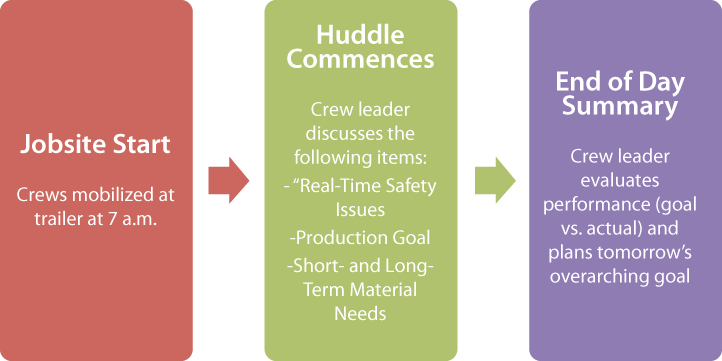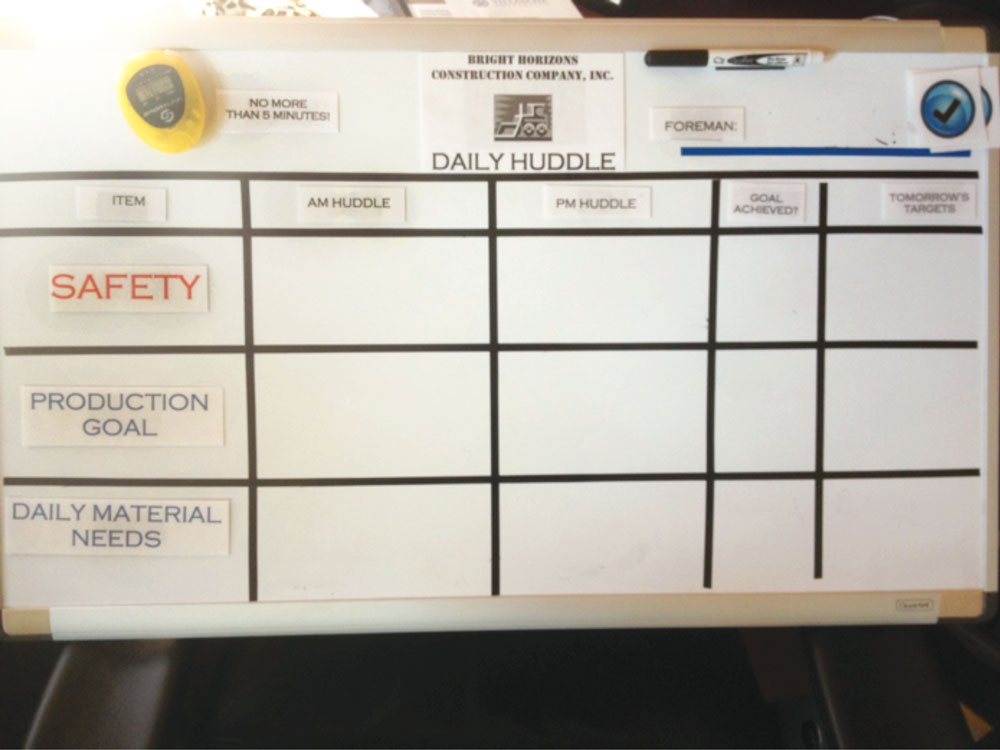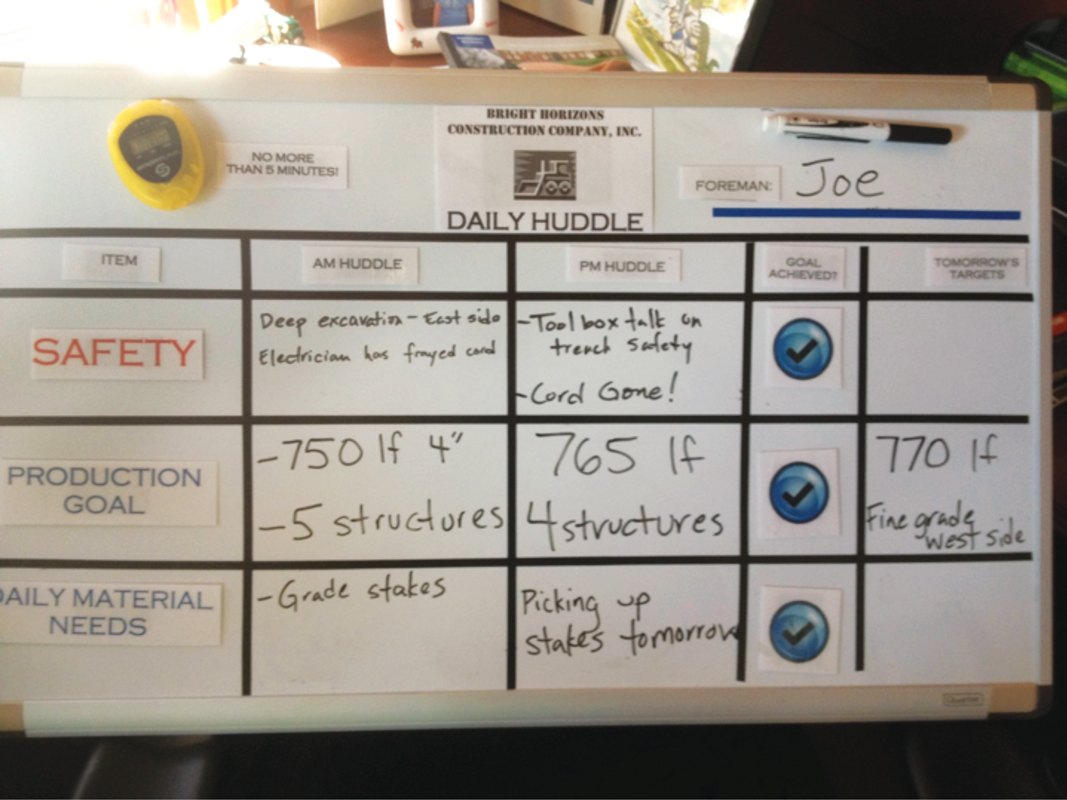Improve your construction crew's productivity in five minutes a day.
Images of Joe Montana, Peyton Manning and Tim Tebow barking signals to their 10 offensive teammates create vivid illustrations of how small planning can influence a game. Within as few as 10 to 15 words, these play callers communicate what each player’s objective and role should be over the next few seconds. These huddles only last seconds, but they can greatly impact each step of a game.
Imagine how productive your construction crews would be if they began each day with this type of huddle.
A typical day on a construction project often begins with crews scrambling for their tools and mustering to their respective work site without huddling together to discuss the day’s plan. This would be the same as the quarterback immediately hiking the ball without anyone having knowledge of the next play. As farfetched as this may sound, construction crews begin every day in this same fashion.
To see if your construction crews operate this way, have your operations managers ask this question to any person on their crew: What is the goal for today? The answers will vary but will often fall within these three categories:
1. The Shoulder Shrug – Often accompanied by a soft spoken “I don’t know,” the shoulder shrug shows the crew does not have a daily huddle.
2. The Eternal Optimist – The answer “Just as much as we can boss” sounds great on the surface—if only estimators could estimate based on this. This is also evidence of a huddle not occurring.
3. The Superstar – “We will get 400 LF installed,” “We will pave to mile marker 100+12,” “We’ll finish the third floor ceiling grid.” This answer shows the team meets regularly and has a plan with measurable goals.
Do not blame your crew members if they respond with one of the first two responses.
The crew leader, foreman and/or superintendent must establish the goals. In most cases, these project leaders know the budget and schedule, and they should provide this information to their workers (similar to the quarterback calling the signals). If someone does not call the signals, the players will dictate their own ways to play the game.
Businesses may develop comprehensive preconstruction plans only to see the execution lost in the small daily details. For instance, if project leaders do not meet with their crews to discuss jobsite conditions, required materials, customer demands and environmental factors that affect the project, they cannot adjust the daily plans accordingly. Crews who work without a huddle may be active but will most likely be unproductive. Activity without direction is a source of margin erosion.
 |
| If project leaders do not meet with their crews to discuss jobsite conditions, required materials, customer demands and environmental factors that affect the project, they cannot adjust the daily plans accordingly. |
The Daily Huddle Process
The daily huddle should not be complicated. Using a visual aid can be helpful to ensure everyone understands the daily objective. I call this visual aid the Daily Huddle Communication Center (DHCC). Figure 2 and Figure 3 below are excellent examples of DHCCs.
The various components of the DHCC include the following:
- Simplicity – Many firms try to accomplish too much in a short huddle. Focus on two to three areas (e.g., safety, production and materials).
- Real-Time Safety – Use job-hazard analyses, and devote immediate attention to safety issues.
- Timing – Stay within a five- to 10-minute time limit. The small stopwatch in the top left corner of Figure 2 keeps the crew leader disciplined to stay within time constraints. Also, ask everyone to stand during the huddle to keep it brief.
- Benchmarking – The afternoon or “PM Huddle” should discuss which goals could not be achieved, and the project leader should determine the cause. This huddle gives the crew a sense of accountability.
- Tomorrow’s Targets – The column on the far right of Figure 2 establishes the goals for the next day.
To display the DHCC, foremen and superintendents can use a dry erase board or a flip chart secured to the side of a trailer. For remote jobsites that lack a trailer or cargo box, foremen can even use a dry erase marker on the hood of their truck to establish the goal.
The tool used for the huddle is not as important as the process involved in creating the daily behavior. Just as everyone understands the value and need to exercise, a construction firm must instill the same behavior in its field managers.
 |
| Figure 2: The Daily Huddle Communication Center |
 |
| Figure 3: Daily Huddle Communication Center Completed |
Buy-In from the Construction Team
The daily huddle concept can be implemented easily, but you must first gain the field crew’s collective buy-in. Implement the following to have successful daily huddles:
- Communicate Clearly – If the team does not understand the playbook, they will never understand the play. Create a common vocabulary that everyone on the team will understand. Consider language hurdles and adjust accordingly.
- Make the Goals Visible – Place the DHCC is in a visible spot, such as break areas, tool cribs, cargo boxes, parking areas, etc.
- Test the Communication – Senior management must conduct routine tests to ensure the huddles happen daily. Spot checks and jobsite quizzes work well. Also, remember to ask the crews the goal of the day.




